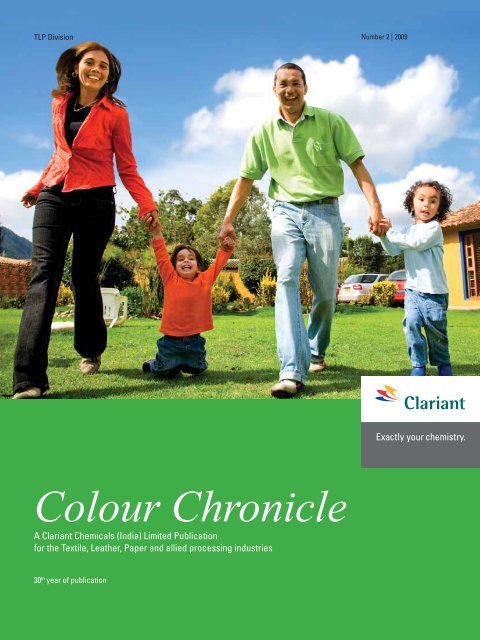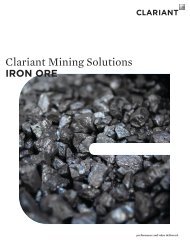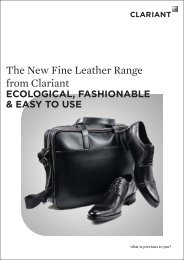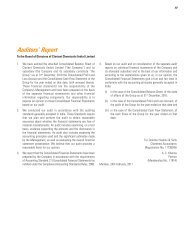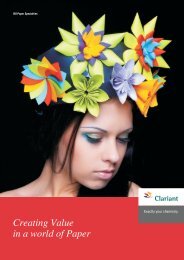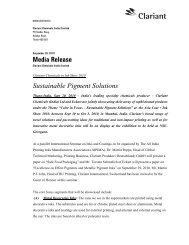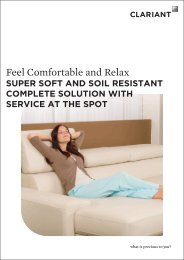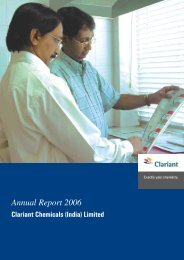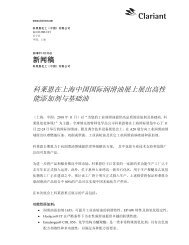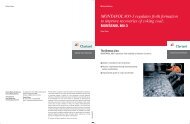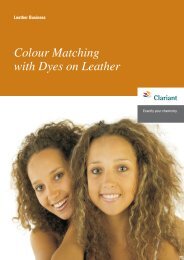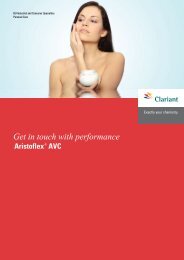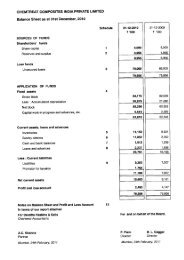Colour Chronicle - Oct 2009 - Clariant
Colour Chronicle - Oct 2009 - Clariant
Colour Chronicle - Oct 2009 - Clariant
Create successful ePaper yourself
Turn your PDF publications into a flip-book with our unique Google optimized e-Paper software.
TLP Division<br />
<strong>Colour</strong> <strong>Chronicle</strong><br />
A <strong>Clariant</strong> Chemicals (India) Limited Publication<br />
for the Textile, Leather, Paper and allied processing industries<br />
30 th year of publication<br />
Number 2 | <strong>2009</strong>
colour chronicle e 2 | <strong>2009</strong><br />
Contents<br />
textile 3<br />
Resin finish<br />
Garment finish<br />
q&a 10<br />
Textile – an essential, rich heritage<br />
paper 13<br />
Surface sizing additives<br />
new arrivals 17<br />
inside views 20<br />
<strong>Clariant</strong>’s Global Shoe Concept:<br />
Society of Dyes and <strong>Colour</strong>ists<br />
gleanings from press 22<br />
2 colour chronicle 2 | <strong>2009</strong>
Resin finish<br />
High-end Resin finish<br />
Purpose:<br />
Excellent wash and wear properties<br />
No ironing or easy to iron<br />
Shape memory<br />
Washfast softness<br />
Washfast smoothness<br />
Wearing comfort<br />
For successful crosslinking<br />
Arkofix NDL liquid c<br />
Low HCHO cross-linking agent for resin fi nishing of<br />
cellulosic fi bres<br />
Arkofix NDF liquid c<br />
Cross-linking agent with very low HCHO values (Law 112)<br />
for resin fi nishing of cotton and viscose<br />
(CV=stronger catalysis required)<br />
Arkofix NEC / NES liquid c<br />
Chlorine retention resistant cross-linking agent with very low<br />
HCHO values (Law 112) for resin fi nishing of viscose and<br />
selected Co qualities<br />
New Arkofix NZF liquid<br />
HCHO-free cross-linking agent for resin fi nishing of<br />
cellulosic fi bres<br />
Important points for Easy - Care,<br />
Crease Resist, No Iron<br />
Fabric and process have to be studied for this purpose and<br />
very well controlled especially for pure cotton fabrics.<br />
More resin, more performance! But the restricting factor<br />
is the loss in strength.<br />
30 to 45 % loss of tensile strength have to be taken into<br />
account.<br />
Fabric: good cotton fi bers quality<br />
extra long staples<br />
yarn construction (no open end for shirts)<br />
weaving and design<br />
textile<br />
Pre-treatment: Very well controlled to ensure minimal damage;<br />
liquid ammonia is a must for<br />
non-iron shirts<br />
Dyeing: All dyes can be used for dry process<br />
(Pad Dry Cure).<br />
Pigments, vat and sulfur dyes are suitable for moist cure.<br />
For wet cure only pigment printed, white fabrics<br />
and some vat dyes are possible.<br />
Before resin fi nishing the pH of the fabric must be slightly acidic<br />
and no alkalinity<br />
Alkalinity < 0.04 g NaOH/100 g of fabric<br />
colour chronicle 2 | <strong>2009</strong> 3
4<br />
textile<br />
Physical performance of resin<br />
treated goods<br />
Advantages and drawbacks of resin finish<br />
+ Durable press rating<br />
+ Low creasing<br />
+ High CRA<br />
+ Easy to iron / non iron<br />
+ Dimension stability<br />
- Loss in tensile strength<br />
- Loss in tear strength<br />
- Abrasion resistance<br />
- Formaldehyde content<br />
Selection of softeners and<br />
additives:<br />
Effects influenced by the right selection<br />
soft handle effect<br />
improvement of tear strength (Elmendorf)<br />
improvement of crease recovery angle<br />
improvement of wash and wear appearance (DP rate)<br />
facilitated ironing<br />
wearing properties<br />
wash permanence<br />
seam slippage<br />
take into account: compatibility with each other, HLV<br />
Influence of additives on tear<br />
resistance<br />
Tearing behaviour according to Elmendorf<br />
cN<br />
colour chronicle 2 | <strong>2009</strong><br />
Arkofix NDF Liq<br />
Raw material<br />
NDF + Fatty acid softener<br />
NDF + Solusoft MW<br />
NDF + Ceraperm SAP<br />
NDF + Solusoft UP<br />
NDF + Velustrol P40<br />
NDF + P40/MW/UP<br />
0 500 1000 1500 2000 2500<br />
Number of Rotations (thousand)<br />
0 2 4 6 8 10 12 14<br />
Permanent Press Influence of<br />
additives<br />
Smoothness aspect (Durable Press)<br />
Raw material<br />
Arkofix NDF Liq<br />
NDF + Fatty acid softener<br />
Arkofix NDF Liq<br />
NDF + Solusoft MW<br />
NDF + Ceraperm SAP<br />
NDF + Solusoft UP<br />
Resistance of pressed creases folds<br />
(Durable Press)<br />
NDF + Velustrol P40<br />
NDF + P40/MW/UP<br />
NDF + Solusoft MW<br />
NDF + Ceraperm SAP<br />
NDF + Solusoft UP<br />
NDF + Velustrol P40<br />
NDF + Fatty acid softener<br />
NDF + P40/MW/UP<br />
0 2 4 6<br />
Raw material<br />
Arkofix NDF Liq<br />
NDF + Solusoft MW<br />
NDF + Ceraperm SAP<br />
NDF + Solusoft UP<br />
NDF + Velustrol P40<br />
NDF + Fatty acid softener<br />
NDF + P40/MW/UP<br />
0 2 4 6 8
Different methods to determine<br />
the smoothness appearance<br />
Common evaluation methods for smoothness appearance<br />
are:<br />
“Smoothness Appearance of fabrics after repeated home<br />
launderings” AATCC 124<br />
ISO 7768 - M&S P134 – DIN EN ISO 15487 -<br />
AFNOR G 07 137-2<br />
Monsanto 1 2 3 3.5 4 5<br />
Smoothness<br />
Appearance<br />
AATCC 124<br />
(Idem für<br />
M&S P134) 1 2 3 3.5 4 5<br />
DIN 53895 1 2 4 6 8 10<br />
100% Cotton<br />
Arkofix NDF liq c 40 - 60 g/l<br />
Catalyst NKS liq 10 - 15 g/l<br />
Ceraperm SAP liq 20 g/l<br />
Solusoft UP liq 30 g/l<br />
Hydroperm RPU liq 20 g/l<br />
pad at room temperature<br />
pickup 70-80%<br />
dry at 130°C<br />
cure for 3 minutes at 150°C<br />
Knitwear recipes<br />
Standard Öko-Easy-Finish<br />
recommendation<br />
Arkofix NDF liq c g/l 20-45 –<br />
Catalyst NKS liq g/l 8-12 –<br />
Arkofix NDK liq g/l – 25-50<br />
Ceralube SVN liq g/l 30-45 –<br />
Solusoft MW liq or<br />
Solusoft UP liq g/l 15 –<br />
Ceraperm SAP liq g/l – 30-40<br />
Hostapal MRN liq c g/l 0.5 0.5<br />
pad at room temperature<br />
pickup 70-80%<br />
dry at cure 170°C; curing time 15 sec.<br />
textile<br />
Formaldehyde-free resin finish on<br />
cotton<br />
Knit Woven<br />
Arkofix NZF New liq 40 - 90 60-180 g/l<br />
Ceralube SVN liq 25 - 35 – g/l<br />
Solusoft MW liq or – 25 g/l<br />
Solusoft WA liq 15 – g/l<br />
Solusoft ACN liq – 15 g/l<br />
Velustrol P40 liq – 20 g/l<br />
Hostapal MRN liq hc 0.5 0.5 g/l<br />
Catalyst NKD liq 4 - 9 6 - 15 g/l<br />
pad at room temperature<br />
Dry: 110 - 130°C<br />
Cure: 20 - 30 s at 160°C<br />
Eco Easy Finish<br />
The simple All in One easy care finish with compound<br />
products<br />
Specially for knit goods of cellulosic fi bres and their<br />
blends with synthetics<br />
One stage process<br />
Guide recipe for outerwear and T-Shirts (white and<br />
coloured)<br />
Stage 1 30-40 g/l Arkofix NDK liq<br />
30-50 g/l Ceraperm SAP liq<br />
0.1-0.3 g/l Hostapal MRN liq c<br />
pad cold<br />
pickup 70-80 %<br />
shock cure for 20-15 s at 170-180°C<br />
(temperature of the goods)<br />
Top-Tex<br />
The uncomplicated Easy Care finish with variable building<br />
block system<br />
For woven and knit goods of cotton and its blends with<br />
synthetic fi bres<br />
One stage process<br />
Guide recipe 100 % Co fabric (lightweight fabric; white<br />
or coloured goods)<br />
Stage 1 30-70 g/l Arkofix NDF liq c<br />
8-17 g/l Catalyst NKS liq<br />
15 g/l Solusoft UP liq<br />
35-40 g/l Ceraperm SAP liq<br />
20 g/l Hydroperm RPU liq<br />
0.3 g/l Hostapal MRN liq c<br />
pad at room temperature<br />
pickup 70-80%<br />
shock cure for 20-15 seconds at 170-180°C<br />
(temperature of the goods) or dry at 130°C and cure 150°C<br />
3 minutes<br />
calendar, sanforize if necessary.<br />
colour chronicle 2 | <strong>2009</strong> 5
6<br />
textile<br />
LT-Cure Finish<br />
The comprehensive low risk finish for highest demands as<br />
an alternative to moist crosslinking with almost the same<br />
effects (no change of shade)<br />
For woven goods of 100 % Cotton.<br />
Three stage process<br />
Guide recipe for 100 % Co fabric (120g/m2)<br />
Stage 1 Resin finish<br />
150-210 g/l Arkofix NDF/NEC Plus liq c*<br />
28-34 g/l Catalyst LT1 liq<br />
10-30 g/l Solusoft MW liq c<br />
30-40 g/l Velustrol P40 liq<br />
0.5 g/l Hostapal MRN liq c<br />
pad at room temperature<br />
pickup 60-70 %<br />
dry at 80°C to residual humidity of 5-8%, then cure 3<br />
min at 130°C<br />
Stage 2 Open width washing :<br />
0.5 g/l Imerol PC liq<br />
open width wash at 40°C<br />
rinse<br />
dry<br />
Stage 3 Top finish<br />
0.5 g/l acetic acid 60 %<br />
30-40 g/l Solusoft MW liq c<br />
30 g/l Ceralube PHD liq c<br />
0-5 g/l Appretan MB extra<br />
0.5 g/l Hostapal MRN liq c<br />
pad at room temperature, pickup 60-80 %<br />
dry at 130°C<br />
sanforize if necessary<br />
Moisture - curing<br />
Complex State of the Art finish with a technically demanding<br />
background<br />
For woven goods of 100% cotton<br />
Three stage process<br />
Guide recipe for 100% Co woven fabric<br />
colour chronicle 2 | <strong>2009</strong><br />
Stage 1 Resin finish<br />
150-200 g/l Arkofix NDL liq c<br />
20-30 g/l Velustrol ASP liq<br />
5 g/l Hydroperm HV liq<br />
110 g/l Catalyst MC1 liq<br />
pad at room temperature<br />
pickup 70-80 %<br />
dry at 90-100°C to 7-9 % residual humidity<br />
roll and batch at room temperature for 20-22 h<br />
Stage 2 Open width washing, drying<br />
2 g/l soda ash<br />
neutralize at 60°C<br />
rinse, neutralize cold with acetic acid<br />
rinse, dry<br />
Stage 3 Top finish<br />
10-25 g/l Solusoft MW liq<br />
15-20 g/l Solusoft UP liq<br />
20 g/l Velustrol ASP liq<br />
10-20 g/l Dicofix SW liq c<br />
(if necessary)<br />
0.5 ml/l acetic acid 60 %<br />
0.3 g/l Hostapal MRN liq c<br />
pad at room temperature, pickup 70-80 %<br />
dry at 120-140°C<br />
sanforize, calander if necessary<br />
<strong>Clariant</strong> priority products<br />
Solusoft SE1 liq NANO - emulsion<br />
special modified siloxaneweakly<br />
cationic, no yellowing<br />
Solusoft MW liq + liq c Micro – emulsionAminomodified silicone<br />
elastomer nonionic<br />
Solusoft UP liq + liq h.c Macro – emulsion modified silicone<br />
elastomer nonionic<br />
Hydroperm RPU liq Hydrophilic multipurpose polyurethane,<br />
ideal for moisture management finish,<br />
additive for resin finish, nonionic
Garment Finish<br />
Enzymatic and Softening<br />
Treatment<br />
Enzymatic treatment :<br />
Bactosol CA liq c 1 %<br />
Sirrix 2 UD pH 4.5<br />
Liquor ratio 10 : 1<br />
50 - 70 min. at 60°C<br />
rinse warm and cold<br />
Softening by Exhaust :<br />
Ceranine HCS liq 2 - 5%<br />
or<br />
Leomin AFK liq 2 - 5%<br />
Solusoft MSJ liq 2.5 %<br />
Ceralube OEW liq 2.5 %<br />
or<br />
Ceraperm JET liq 1 - 4 %<br />
or<br />
Solusoft HIS liq 1- 4%<br />
Liquor ratio 10 : 1<br />
20 min at 30 - 40 °C, pH 5<br />
Hydroextract, Tumble dry<br />
Economical Garment softening<br />
Ceranine HCS liq<br />
Cationic softener for a smooth,<br />
soft handle for all types of washed<br />
apparel.<br />
Leomin AFK liq<br />
Cationic softener and ozone<br />
protector for washed denim jeans<br />
Ceralube OEW liq<br />
Weakly cationic silicone<br />
compound containing a special<br />
fatty acid softener and a lubricant<br />
with a very soft, fl owing handle.<br />
Super-Soft Finish<br />
Process : Garment - Dip<br />
Recipe :<br />
Solusoft UP liq 70 g/l 4.2 % owf<br />
Solusoft MW liq c 30 g/l 1.8 % owf<br />
Hydroperm RPU liq 30 g/l 1.8 % owf<br />
Dip about 10-20 minutes at about 30°C<br />
Hydroextract to a wet pick up of 60%<br />
Tumble dry at 90-100°C to a residual moisture of 8-9%<br />
Ironing and pressing of the desired shape<br />
Cure in a curing-oven, 4 minutes at 150°C<br />
Hydrophilic Finish/Moisture<br />
Management<br />
Process : Garment - Dip for PA and cotton<br />
Recipe :<br />
Solusoft TOW liq c 30 g/l 1.2 % owf<br />
Hydroperm RPU liq 30 g/l 1.8 % owf<br />
Dip about 10-20 minutes at about 30°C<br />
Hydroextract to a wet pick up of 60%<br />
Tumble dry at 90-100°C to a residual moisture of 8-9%<br />
Ironing and pressing of the desired shape<br />
Cure in a curing-oven, 4 minutes at 150°C<br />
textile<br />
colour chronicle 2 | <strong>2009</strong> 7
8<br />
textile<br />
Physical Performance of Resin<br />
treated Goods:<br />
Advantages and drawbacks of resin finish<br />
+ Durable press rating/Smoothness appearance<br />
+ Low creasing<br />
+ High CRA<br />
+ Easy to iron / non iron<br />
+ Dimension stability<br />
– Loss in tensile strength<br />
– Loss in tear strength<br />
– Abrasion resistance<br />
– Formaldehyde content<br />
Garment High-end Resin finish<br />
Sequence for Garment Resin<br />
finish<br />
1<br />
4<br />
made into<br />
garments<br />
iron and press<br />
colour chronicle 2 | <strong>2009</strong><br />
2<br />
dye dip finish with<br />
resin + softner<br />
followed by<br />
hydroextraction<br />
and tumble<br />
5<br />
drying<br />
cure<br />
1. Impregnating the made up garments with a<br />
resin fi nishing formulation by dipping or by<br />
spray application<br />
2. Hydroextraction (usually not necessary in<br />
case of spray application)<br />
3. Tumble drying<br />
4. Ironing<br />
5. Pressing<br />
6. Curing in a special curing oven<br />
3<br />
Required Machinery Park for<br />
Garment dip<br />
?<br />
?<br />
?<br />
?<br />
1. Rotary washing machine or garment<br />
dyeing machine* (eventually<br />
equipped with spray system)<br />
2. Centrifuge<br />
3. Tumble drying<br />
4. Garment pressing equipment<br />
5. Special curing oven<br />
(min temp. 150°C)<br />
? ?<br />
?<br />
*= Ideally fi tted with a pumping device to pump<br />
back spent fi nishing liquor into the stock<br />
chemical holding tank<br />
Prefinish for easy making up<br />
Garments<br />
Ceralube SVN liq 10 - 40 g/l<br />
Solusoft MW liq c 5 - 25 g/l<br />
Hostapal MRN liq c 0.3 - 0.6 g/l<br />
pad, dry 120 -140°C<br />
followed by sanforising or compacting treatment (important<br />
to avoid shrinkage or puckering during further processes of<br />
the textile)<br />
Notice:<br />
If a fluorocarbon finish (Water-/Oil repellent, Soil Release) is<br />
applied after the garment making we recommend the following<br />
recipe for the prefinish:
Basic Formulation for<br />
“Wrinkle-Free” finish<br />
Arkofix NDF liq c 3 - 8 % owf<br />
Catalyst NKC liq 1.5 - 4 % owf<br />
Ceralube SVN liq 4 % owf<br />
Solusoft MW liq c 2 % owf<br />
Solusoft UP liq hc 1.5 % owf<br />
Hydroperm RPU liq 2 % owf<br />
pH adjustment to 5 with acetic acid<br />
Basic formulation for Resin finish<br />
+ Water and Oil - Repellency<br />
Arkofix NDF liq c 3 - 8 %<br />
Catalyst NKC liq 1.5 - 4 %<br />
Ceraperm SFC liq 2 %<br />
or Ceralube PHD liq c 1-2 %<br />
Nuva TTC liq 4 - 6 %<br />
pH adjustment to 5 with acetic acid<br />
Dip for about 20 minutes at 30°C<br />
Hydroextract to a wet pick up of 60%<br />
Tumble dry at 90 - 100°C to a residual moisture of<br />
10-12%<br />
Ironing and pressing of the desired shape<br />
Curing in a curing oven, 6-8 minutes at 150°C<br />
textile<br />
Basic Formulation for Resin finish<br />
+ Soil Release finish<br />
Arkofix NDF liq c 3 - 8 %<br />
Catalyst NKC liq 1.5 - 4 %<br />
Ceraperm SFC liq 2 %<br />
or Ceralube JW liq 2 %<br />
Nuva SRCN liq 6 - 8 %<br />
pH adjustment to 5 with acetic acid<br />
Dip for about 20 minutes at 30°C<br />
Hydroextract to a wet pick up of 60%<br />
Tumble dry at 90 - 100°C to a residual moisture of<br />
10-12%<br />
Ironing and pressing of the desired shape<br />
Curing in a curing-oven, 6-8 minutes at 150°C<br />
Calculation in g/l<br />
Example : Arkofix NDF liq c = 5 % owf<br />
PA = chemical amount which should be onto<br />
the fabric<br />
LA = liquor pick up after fi nishing and centrifuging<br />
Hydroextract to a wet pick up of 60 %<br />
g/l = 1000 x PA = 1000 x 5 = 83<br />
LA 60%<br />
g/l = 83<br />
<strong>Clariant</strong> Silicone Products<br />
Solusoft SE1 liq NANO - emulsion<br />
special modified siloxane weakly cationic,<br />
no yellowing<br />
Solusoft MW liq + liq c Micro – emulsion Amino modified silicone<br />
elastomer nonionic<br />
Solusoft UP liq + liq h.c Macro – emulsion<br />
modified silicone elastomer<br />
nonionic<br />
Solusoft WA liq Semi-macro – emulsion<br />
Aminomodified elastomer cationic<br />
colour l chronicle h i l 2 | <strong>2009</strong> 9
10<br />
q&a<br />
Mr. Basu<br />
President<br />
M/s Nahar Industrial<br />
Enterprises<br />
– March 9, 1957<br />
– Schooling:<br />
Bankura Zilla School,<br />
West Bengal.<br />
– Professional course:<br />
B. Text Colcutta<br />
University, 1978.<br />
– Total career:<br />
31 years<br />
– Worked with:<br />
Banwar Mills, Kohinoor<br />
Bombay, Indian Rayon,<br />
Pasupati, Modern<br />
Terry Towel, Arvind<br />
Mills, Opex Group-<br />
Bangladesh,<br />
Auro Textile and<br />
currently Nahar Fabric.<br />
– Current designation:<br />
President.<br />
colour chronicle 2 | <strong>2009</strong><br />
Textile – an essential,<br />
rich heritage<br />
1. Do you think the Textile industry today is facing<br />
a Global Recession?<br />
Yes, Textile Industry is facing today a Global<br />
Recession due to the economic conditions ofAmerica<br />
and Europe.<br />
2. How do you assess the threat from China?<br />
I don’t consider China as a threat any more due<br />
to lack of quality in their product and changed<br />
government policies.<br />
3. What innovations do you plan with reference<br />
to branding, retailing new products and new<br />
fi nishes?<br />
Regarding Branding we are already having our<br />
established brands viz. Monte Carlo, Cotton County,<br />
French Republic and Tazo and our Retail Business<br />
is already in place. We are trying to strenghten our<br />
Brands and Retails Business by creating Brand<br />
Loyalty through quality at reasonable price.<br />
Regarding new products we are focusing more on<br />
Elasten Fibre and increasing our capacity of Elasten<br />
Fibre yarn as use of Elasten Fibre is increasing. We<br />
are trying to increase our presence in workwear<br />
segment. Dobby Design is the strength of Nahar<br />
Group. We are trying to exploit our strength.<br />
Regarding new fi nishes we are doing different type<br />
of performance fi nishes too for brands.<br />
4. How do you envisage the growth of brands and<br />
its impact on textile business?<br />
It will improve the quality standard.<br />
5. What are your plans to expand your International<br />
Textiles and Retail business?<br />
In Nahar we are doing lot of work for Direct Export<br />
and Export through RMG sector. Keeping this<br />
segment in view we expanded in 2006. Now we are<br />
waiting for International Textile Market to Improve.<br />
At right time we will think about expansion.<br />
6. How do you see the role of dyes and chemical<br />
manufacturing companies (<strong>Clariant</strong>) in future to<br />
help the textile industry?<br />
In the present scenario of Textile Market the role<br />
of Dyes Chemical Manufacturing Companies like<br />
<strong>Clariant</strong> has become very crucial and cirtical. On the<br />
one hand the performance requirement is being more<br />
stringent and on the other hand price of the fi nished<br />
fabric is not increasing. In manufacturing cost dyes<br />
and chemicals is the second largest constituent i.e.<br />
13-15% of the total manufacturing cost. So in this<br />
context all the dyes and chemicals manufacturers<br />
will have to be very innovative, quality conscious,<br />
cost competitive and service oriented to help the<br />
Textile Industry as well as for themselves.<br />
7. Your message to textile industry<br />
Textile is one of the basic needs of human being and<br />
India is having a rich heritage in Textile. Sooner or<br />
later we would come out of the present recession.<br />
We would have to punch in a little creativity along<br />
with cost effectiveness to be the world leader.
Surface sizing additives<br />
Cartacol® 6411 liquid and Cartacol® SA liquid<br />
The Cartacol range<br />
Surface sizing additives<br />
Benefi ts:<br />
– Reduce water, moisture and water-based ink<br />
penetration<br />
– Improve inkjet printability<br />
– Better cost/effi ciency ratio<br />
Applications:<br />
– Multipurpose<br />
– Packaging: boxboard, containerboard, corrugated<br />
board, kraftliner, testliner, coated board<br />
Cartacol SA liquid<br />
Surface sizing emulsion polymer - mainly Styrene/<br />
Acrylate type, 25 % AC<br />
Nano-polymer particles<br />
Excellent electrolyte, shear and thermal stability<br />
Used on uncoated paper, in size-press colors together with<br />
starch and OBA<br />
Designed for optimizing the inkjet printability of<br />
multipurpose printing paper (offi ce paper), with positive<br />
effects on the toner adhesion<br />
Cartacol 6411 liquid<br />
Surface sizing emulsion polymer - mainly Styrene/<br />
Acrylate type,<br />
High solid content, 35 % AC<br />
Excellent electrolyte, shear and thermal stability<br />
Used on uncoated board to enhance the water hold out<br />
(low penetration in the base paper)<br />
Good printability of multipurpose printing paper<br />
Difference between coated and<br />
uncoated paper<br />
Uncoated office paper<br />
Matt coated paper<br />
paper<br />
colour chronicle 2 | <strong>2009</strong> 13
14<br />
paper<br />
Surface sizing mechanism Uncoated paper<br />
Surface treatment with a surface sizing agent<br />
Uncoated paper<br />
colour chronicle 2 | <strong>2009</strong><br />
Office paper performance criteria<br />
Special emulsion polymers to improve the print performance<br />
by inkjet and digital printing<br />
Sizing: Cobb, HST, contact angle<br />
Inkjet print:<br />
Black/color density<br />
Image/text defi nition<br />
Wicking, feathering, 2 color bleeding<br />
Dot size/sharpness<br />
Digital: Photocopy/laser<br />
Toner adhesion<br />
Runnability (friction coeffi cient )<br />
Offset printability:<br />
Wet surface strength (SWAT, wet IGT ...)<br />
<strong>Clariant</strong> inkjet printing test<br />
Black text definition <strong>Colour</strong> definition<br />
Sharpness<br />
HP895Cxi Rapport Inkjet printing test<br />
Black density <strong>Colour</strong> density, mottling<br />
Mottling<br />
<strong>Colour</strong> feathering<br />
Bleeding<br />
(2 colour mixing)<br />
Inkjet printing test<br />
NETTETE
Digital printing<br />
Toner adhesion and friction coefficient<br />
0.8<br />
0.7<br />
0.6<br />
0.5<br />
0.4<br />
0.3<br />
0.2<br />
B.<br />
Cartacol SA<br />
Surface sizing - Case history<br />
Office paper - Cartacol SA<br />
Paper Grade : 80g/m² P = 5T/h, v = 460m/min<br />
Size press : 6.5% starch<br />
Leucophor ® UKO; Cartacol SA = 2kg/T of final paper<br />
Dosing point of SSA : in working reservoir of 6.5%<br />
starch/ Leucophor UKO solution, Temperature = 42-44°C,<br />
pH = 7.2<br />
paper<br />
Results :<br />
Cobb (gH2O/m² ):<br />
– Uncured (AKD sizing) = 24 – 25g/m²;<br />
– Cured (5 minutes at 130°C) = 21 ±1g/m² -same<br />
results with both SSA<br />
Ink-jet printability (HP printer, standard ink-jet printing<br />
form): excellent<br />
Good toner adhesion<br />
Paper Grade : Offset paper 70 – 80g/m², 150m/min<br />
Pulp: Straw 30 – 50 / bleached fi ber 50 – 70%<br />
Wet end conditions : AKD internal sizing 15kg/T<br />
Surface treatment<br />
– Tapioca or corn oxidized starch 6 – 10%, pH 7.5<br />
– CARTACOL SA 3-6kg/T<br />
– Temperature 35°C<br />
– Coat weight 2.5g/m², Pond size press<br />
Advantages<br />
– Same Dry surface strength (using IGT) than competitor<br />
speed = 2,50 / 2,95m/s Top/ Bottom side<br />
– Same Cobb 60s = 32/33g/m²<br />
Cartacol 6411<br />
Office paper<br />
Started with the same dosage as competition but later on<br />
decreased to 20% less<br />
Paper – 80g/m²<br />
AKD in wet-end<br />
Size press formulation : 7% conc starch + SSA<br />
Competitor added constantly per dosing pump 2.5 kg as is/<br />
T final Cobb values of 22gH2O/m²<br />
Cartacol 6411 addition was reduced to 2.0 ks as is/<br />
T final paper<br />
No changes regarding Cobb and inkjet printability was<br />
detected<br />
www.paper.clariant.com<br />
This information is based on our present state of knowledge and is<br />
intended to provide general notes on our products and their uses.<br />
It should not therefore be construed as guaranteeing specific<br />
properties of the products described or their suitability for a<br />
particular application. Any existing industrial property rights must<br />
be observed. The quality of our products is guaranteed under our<br />
General Conditions of Sale. ® Trademark of <strong>Clariant</strong> registered in<br />
numerous countries. © 2008 <strong>Clariant</strong> International Ltd.<br />
colour chronicle 2 | <strong>2009</strong> 15
Bactosol BP liq. c<br />
A specific cellulase enzyme for Biowash treatments.<br />
Improves signifi cantly soft feel of the garment.<br />
Removes fuzziness on surface of the fabric during<br />
production<br />
Less colour fading after multiple laundering<br />
Rapid Kinetic behavior reduces the treatment time of the<br />
biowash. Therefore energy cosumption cost are saved and<br />
productivity increases.<br />
Specifi c action on surface of the fi ber, low impact on fi ber<br />
strength compared to traditional cellulases.<br />
Afilan GD liq.<br />
Lubricant with antistatic properties for fiber<br />
manufacturing and fiber processing.<br />
Afi lan GD Liq. has got excellent lubricating and wetting<br />
properties ,improves fi bre/fi bre cohesion and reduces<br />
fi bre /metal friction.<br />
Owing to the high degree of dynamic smoothness and<br />
good fi bre- to- fi bre cohesion Afi lan GD liq. is suitable<br />
as lubricant for fi bre manufacture and fi bre processing<br />
in the fi eld of PAN as well as PET and all other fi bre<br />
catagories.<br />
Can be applied from aqueous solutions either alone or in<br />
combination with other nonionic or anionic fi bre fi nishes<br />
in the fi bre manufacturing and textile mills,mainly as<br />
spinning lubricant.<br />
Drimaren Red HF-B<br />
New High Concentrated Bright Red for Exhaust and<br />
Continuous application for Medium to dark shades.<br />
Concentrated dye with attractive Bright Red shade.<br />
Possible to match Bright Red,<br />
new arrivals title<br />
scarlet and Blood Red shades.<br />
Suitable for exhaust and continuous application process.<br />
Good compatibility within Drimaren HF/CL range.<br />
Has Good Light fastness in Medium and Dark shades.<br />
Good Wet Light and Wet alkali light (M&S C9A)<br />
fastness.<br />
High fi xation and Good washing-off properties.<br />
Good Acid and Alkaline perspiration fastness.<br />
Indosol Black NF p 1200<br />
Metal free direct dye for dyeing cellulosic fibers.<br />
Product Performance<br />
Direct black with good build up. One bath dyeing of PES/<br />
CEL under HT conditions must be dyed at pH 9 -10<br />
Good coverage of dead cotton<br />
HT Suitability 130°C at pH 5 : Not suitable<br />
No infl uence of iron contamination in dyebath on the<br />
shade<br />
Shade in artifi cial Light : Yellower<br />
Leveling power for Co/CV : CV dyed much deeper<br />
Stability to hard water (17°d) : Stable<br />
Drimaren PS<br />
After several years of having either locally sourced for<br />
non competitive products we are happy to offer you now<br />
a new global range of own products for reactive printing.<br />
To clearly separate them from former products we call<br />
them DRIMAREN PS dyes.<br />
These are 12 monochloro triazine dyes.<br />
The main targets behind those developments have been:<br />
– granulated form to be superior to most of<br />
competitors’ dusting powders<br />
colour chronicle 2 | <strong>2009</strong> 17
18<br />
new arrivals<br />
– economical products<br />
– high solubility to enable working even without predissolving<br />
– low salt content for less negative infl uence on<br />
synthetic thickener and better washing- off properties<br />
(less staining).<br />
Printofix Orange R-R Eco<br />
Orange with Banned Amine Free.<br />
Suitable for DCB-free : Black/Orange Combination Print<br />
Can be promoted as unique product in<br />
Corporate and EOU.<br />
Suitable for Babywear.<br />
Very High Light Fastness.<br />
Good Perspiration and Chlorine fast.<br />
Printofix Red R-G Eco<br />
Eco-friendly Red Pigment Dispersion<br />
Product Performance<br />
“Banned amine free”, red dispersion for pigment<br />
printing.<br />
Good light, dry clean and wash fastness.<br />
Very little infl uence on viscosity of synthetic thickener.<br />
Suitable for all types of printing applications i.e., aqueous,<br />
semi-aqueous and solvent based.<br />
Does not contribute in gelling of printing paste.<br />
Printofix Binder ITL<br />
GOTS Approved, Formaldehyde Free Binder for Aqueous<br />
Printing<br />
Printofi x Binder ITL has been specially developed for<br />
Pigment Printing by the aqueous system, in combination<br />
with Printofi x Thickener CA / CSN / ECS<br />
Printofi x Binder ITL gives prints with good colour value,<br />
sharpness, brightness and softness.<br />
It is suitable for printing on cotton (both woven and knit<br />
fabrics), viscose, polyester and their blends. Printed goods<br />
have high all round fastness properties.<br />
colour chronicle 2 | <strong>2009</strong><br />
Printofix ® Binder 83.IN liq.<br />
Binder for pigment printing on cellulosic and synthetic<br />
fabrics and blends, e.g. on polyester/cellulosic fabrics.<br />
high all-round fastness properties<br />
provides pleasant soft handle<br />
good resistance to mechanical strain<br />
excellent running properties on printing machines<br />
good stability to light ageing<br />
Excellent Washing Fastness<br />
Printofix ® Binder T20-20 liq.<br />
Very Soft Binder for pigment printing on cellulosic and<br />
synthetic fabrics and blends.<br />
provides very good soft handle<br />
good all-round fastness properties<br />
good resistance to mechanical strain<br />
excellent running properties on printing machines<br />
Esp. recommended for printing of knits<br />
Printofix Softener SFT liq.<br />
A special silicone macro emulsion for Pigment Printing<br />
Very good softness along with best rubbing fastness level<br />
on pigment printed textiles.<br />
Elegant surface smoothness<br />
Especially recommended for pigment printing on knitwear<br />
Provides better elasticity to the prints<br />
Improves fastness to dry rubbing of pigment prints<br />
Shows no negative infl uence on wet rubbing fastness<br />
Compatible to all products of the Printofi x range<br />
No negative infl uence on viscosity of the print paste<br />
Shows very good permanency<br />
Drimagen AB liq.<br />
A liquid alkali system for Reactive dyeing<br />
Controls the fi xation of reactive dyes in an uniform way.<br />
Permits improvement of dyeing reproducibility.
Compared to conventional alkalies like soda-ash,Drimagen<br />
AB has the following advantages -<br />
1. Easy handling and dissolution.<br />
2. Better security and reproducibility of dyeings.<br />
Exceptional pH stability in use.<br />
Leonil EHC liq.<br />
Anionic, non-foaming wetting agent for continuous<br />
dyeing of cellulosic fibres and their blends with<br />
synthetic fibres<br />
has excellent wetting properties and facilitates penetration<br />
of diffi cult to penetrate cellulosic grey goods<br />
can be applied in all neutral, acid and alkaline dyeliquors<br />
in exhaust and continuous processes<br />
has no retarding effect on reactive, vat, sulphur or direct<br />
dyes and does not impair their solubility<br />
prevents vat skinning and smears when dyeing with vat<br />
and sulphur dyes<br />
is low-foaming under all pH conditions<br />
is silicone-free<br />
Opticid HAI liq.<br />
Acid buffer and dispersant for dyeing of polyester and<br />
polyester/cellulosic blends.<br />
Maintains a constant pH during the dyeing process.<br />
Often replaces the dispersant.<br />
Does not foam.<br />
Is easy to handle in the liquid commercial form.<br />
Is phosphate-free.<br />
Lyogen DP c<br />
Excellent leveling agent for Polyester Dyeing due to its<br />
inbuilt properties of Leveling, Migration and Dispersion<br />
with ability to cover barriness in uneven texturised PES.<br />
Product Performance<br />
Leveling properties based on dual action, migration and<br />
retardation.<br />
Good dispersion properties.<br />
Non – foaming.<br />
new arrivals<br />
Highly concentrated. Dosage required is 25% lower than<br />
most of the available leveling agents.<br />
No effect on sensitive dyes and shades especially green,<br />
turquoise.<br />
Product can also be used effectively for Stripping and<br />
Shade Correction.<br />
Also effective for dyeing of PES in blends.<br />
APEO / NPEO free. OkeoTex compliance.<br />
Minimal wool fi ber damage dyeing in the iso-electric<br />
region – pH 4.5.<br />
Very high fastness on wool to ‘in house’ processing.<br />
Metal Free.<br />
Ceralube ET.IN liq.<br />
Cost Effective Yarn Lubricant<br />
Ceralube ET.IN liq is the blend of micro fi ne waxes to achieve<br />
minimal yarn to metal and yarn to yarn coeffi cient of friction.<br />
It enhances runability of yarn and minimizes breakages in<br />
post winding.<br />
It is a cost effective product in its category to be used for<br />
reducing coeffi cient of friction. It is suitable for all fi bres.<br />
Product Performance<br />
Excellent lubricity for post winding operations.<br />
Minimizes Coeffi cient of Friction in yarn to yarn and yarn<br />
to metal.<br />
Glossy and waxy fi nishes can be achieved by padding<br />
application on cotton fabrics, with improvement in<br />
sewability properties.<br />
Trefix SW pa<br />
The new sizing softener for Cotton, P/C, P/V and 100%<br />
Polyester and viscose spun yarn.<br />
Product Performance<br />
Easy splitting of yarn in split zone and imparts pliability<br />
to yarn to overcome abrasion in weaving.<br />
Good lubrication property lowers yarn friction on loom.<br />
Reduces shedding during weaving by reducing Fibre to<br />
Fibre and Fibre to Metal friction.<br />
Compatible with all sizing ingredients.<br />
Can be added in cooker.<br />
colour chronicle 2 | <strong>2009</strong> 19
20<br />
inside views<br />
<strong>Clariant</strong>’s Global Shoe Concept:<br />
Global information – local interpretation<br />
colour chronicle 2 | <strong>2009</strong><br />
Impressions from Brazil<br />
Under the motto “Always one shoe step ahead”<br />
- <strong>Clariant</strong>’s Leather Business has successfully<br />
continued to advance its international shoe approach<br />
by holding three global development workshops<br />
in the main shoe centres of Asia and Americas. In<br />
line with the launch of its Global Shoe Concept,<br />
the company continues to address the shoe upper<br />
market with a strong focus on trend, innovation,<br />
performance and ecology. The objective of these<br />
local workshops was to generate innovative<br />
and fashionable ideas to cater for customers’<br />
needs in the respective regions and countries.<br />
Workshop in Asia and Americas:<br />
The workshops took place in Chennai/India,<br />
Guangzhou/China and Novo Hamburgo/Brazil.<br />
Local teams with the support by the project<br />
leader Ralph Schneider from Germany as well<br />
as international technicians responsible for the<br />
respective countries spent one week together<br />
recently to exchange experiences, strengthen<br />
teambuilding and establish the strategy to offer our<br />
customers the most updated and complete solution<br />
and application.<br />
The leathers made show a wide variety of shoe<br />
uppers from burnishable goat to high performance<br />
bovine box and oily types.<br />
‘Specifi cally, the shoe segment will be the focus<br />
for our future growth. The results of our workshops<br />
clearly demonstrate our leading position in this<br />
area of innovative leather chemicals, based on<br />
our commitment to provide real solutions for our<br />
special customer requirements. <strong>Clariant</strong> provides<br />
application know-how, based on an updated product<br />
portfolio for all segments of our industry’, states<br />
Hubert Kollmar, Head of Leather Business for Latin<br />
America.<br />
All workshops clearly show that the possibilities<br />
are unlimited and can be exchanged between the<br />
countries and regions when taking local requirements<br />
like raw material into account. In the current<br />
economic climate, it’s absolutely necessary that<br />
tanners can easily generate new ideas and discover<br />
new areas of business with new stylish effects and<br />
safe and environmentally-friendly processing.<br />
Key elements of <strong>Clariant</strong>’s global shoe concept:<br />
International cross-functional teams<br />
Considering local and global requirements (e.g.<br />
use of local raw material)<br />
Using a core range of products/systems for shoe<br />
(globally and locally manufactured)<br />
Use of environmentally-friendly technologies<br />
Seasonal fashion approach around 18 to 24<br />
months before the fashion seasons<br />
Continuous approach with the latest trends from<br />
the main fashion areas in Europe<br />
<strong>Clariant</strong> has resources, products and systems,<br />
covering the full range of shoe technologies, and<br />
dedicated techno-commercial expertise and market<br />
intelligence.<br />
Sense the difference and feel the fashion - for<br />
more information please consult your local <strong>Clariant</strong><br />
representative and make use of <strong>Clariant</strong>’s support.<br />
Impressions from China<br />
Impressions from India
Society of Dyes and <strong>Colour</strong>ists<br />
Society of Dyers and <strong>Colour</strong>ists,<br />
India organized the fi rst ever Global<br />
Conference in Goa on June 25–26, <strong>2009</strong>.<br />
The Theme for the workshop was Sustainability<br />
in <strong>Colour</strong>ation: Vision 2020.<br />
Sustainabiltiy as a part of the theme suggested<br />
that we have to look at sustaining the universe and<br />
most importantly ourselves and our Businesses.<br />
Vision 2020 implies that colouration industry<br />
would go ahead with a view which would be smart<br />
and sharp.<br />
Mr. A.K. Prasad received Fellowship of The<br />
Society of Dyers and Colorists [C Col, FSDC]<br />
which was handed over to him by Dr. Mike Bartle,<br />
Chairman of SDC, UK.<br />
<strong>Clariant</strong> Chemicals (India) Ltd. also had put up a<br />
promotional counter where we interacted with many<br />
of customers and designers from India and elsewhere.<br />
It was pleasure to know that many customers showed<br />
keen interest in colour chronicle.<br />
<strong>Clariant</strong> was also represented by Ms. Beate and<br />
Mr. Kieth and Mr. Sebastian from Santitized AG.<br />
Ms. Beate gave a brief profi le and contribution<br />
made by <strong>Clariant</strong> globally on colouration, fashion<br />
trends and novelty effects by speciality fi nishes.<br />
This forum was also successfully utilized for<br />
informal discussions with different customers and<br />
we enlightened them on the latest from <strong>Clariant</strong> for<br />
value addition.<br />
Grand fi nal of SDC’s Global Design Competition<br />
was also hosted by SDCEC during the course of<br />
these two days where fashion designing students<br />
from various countries participated. We were the<br />
sponsors of the Awards function dinner of this<br />
Global design competition.<br />
More than 200 delegates participated in this<br />
event. This was well represented by suppliers,<br />
manufactures, brand representatives, professors,<br />
and students. Presentations were also made by other<br />
allied service providers in the fi eld of textiles.<br />
At the end SDC thanked all the lead sponsors<br />
of the conference, speakers and students who had<br />
come from all the parts of the world.<br />
Dr. Mike Bartle presenting fellowship certificate to Mr. A. K. Prasad.<br />
<strong>Clariant</strong> Team with the winners of Global Design Competition.<br />
inside views<br />
colour chronicle 2 | <strong>2009</strong> 21
22<br />
gleanings from press<br />
Climate neutral T-shirts<br />
from Switcher<br />
Since January <strong>2009</strong>, the Swiss textile<br />
company Switcher has been co-operating<br />
with myclimate in climate protection. All<br />
emissions of its collection “CO2 neutral”<br />
as well as print emissions of its catalogues<br />
are offset in a project promoting effi cient<br />
biomass stoves and briquetting in<br />
Uttarakhand, India.<br />
Switcher has<br />
as its vision<br />
“to become the fi rst Swiss textile group,<br />
with strong performance and profi tability,<br />
to adopt the principle of sustainable<br />
development on a worldwide basis”.<br />
Myclimate is a Swiss foundation<br />
that is making a signifi cant and innovate<br />
contribution to climate protection and<br />
sustainable development. Myclimate is<br />
well-connected globally and is a leading<br />
quality provider of climate education and<br />
Carbon Management Services. Myclimate<br />
is also a renowned partner for carbon<br />
offsetting solutions via effective carbon<br />
offset projects.<br />
In 1981, when he was still a student<br />
at the University of Lausanne, Robin<br />
Comelius fi rst launched the idea that was<br />
to become the Switcher trademark. For<br />
him, the sweatshirts of the “yuppy” era<br />
were too monotonous “rugby stripes and<br />
symbols of American colleges” and he<br />
dreamed of comfortable and colourful polo<br />
shirts, in solid colours, and above all, with<br />
no slogans. When it was launched, the fi rst<br />
collection included only two models: A<br />
T-shirt and a sweatshirt.<br />
Tactical Response<br />
Combat Shirt featuring<br />
CORDURA Baselayer<br />
fabric<br />
Invista’s Cordura brand team has<br />
announced the launch of Atlanco’s new<br />
colour chronicle 2 | <strong>2009</strong><br />
Tru-Spec brand Tactical Response Combat<br />
Shirt featuring Cordura Baselayer fabric.<br />
The Tactical Response Combat Shirt is<br />
the latest addition to the Tru-Spec brand’s<br />
Tactical Response Uniform (TRU) line for<br />
tactical operations.<br />
“We are excited to work with the Tru-<br />
Spec brand product development team<br />
on this new combat shirt for military,<br />
tactical, and law enforcement end-users,”<br />
said Cindy McNaull, Global Cordura<br />
brand Manager. “In addition to servicing<br />
today’s war fi ghters, this collaboration will<br />
expand the use of Cordura Baselayer fabric<br />
beyond military applications and will<br />
affordably equip hometown heroes with<br />
the latest proctective garment technology.<br />
The comfortable, breathable Cordura<br />
Baselayer fabric will be a valuable asset to<br />
those wearing the new Tactical Response<br />
Combat Shirt.”<br />
Designed to be worn under protective<br />
vests, the Tactical Response Combat Shirt<br />
is a next-to-skin garment constructed with<br />
No Melt/No Drip Cordura Baselayer fabric,<br />
the secret to the shirt’s protective qualities.<br />
The 60/40 cotton-nylon fi bre blends reduces<br />
these verity of burn injuries by chaming<br />
instead of melting when exposed to heat.<br />
Known for its durability and abrasionresistant<br />
characteristics, Cordura Baselayer<br />
fabric provides a comfortable, breathable,<br />
lightweight solution with exceptional<br />
moisture management properties.<br />
“Cordura Baselayer fabric was the<br />
obvious choice for us during the TRU<br />
combat shirt design process,”said Atlanco’s<br />
Vice President of Marketing. Darrell<br />
Jacks. “The fabric’s proven performance<br />
military protective gear further motivated<br />
our support of the brand’s technology. By<br />
ustilising Cordura Baselayer fabric in the<br />
TRU Combat Shirt, the Tru-Spec brand<br />
tear maintains its commitment to making<br />
affordable cutting-edge textile technologies<br />
available to individual operators, as well as<br />
teams and units.”<br />
Atlanco’s Tru-Spec brand launched<br />
its dynamic, full featured Tactical<br />
Response Uniform in 2006 to address<br />
the special needs of tactical offi cers.<br />
Since the uniform’s introduction, the<br />
TRU line has become leading choice of<br />
tactical teams everywhere. I addition to<br />
exceptional comfort and enhanced safet<br />
the Tactical Response Combat Shirt<br />
features a modturtleneck designed for<br />
style and comfort, gussete sleeves for<br />
easy movement, convenient zippere sleeve<br />
storage.<br />
The Tru-Spec brand Combat shirt’s<br />
fully function sleeves, based on the<br />
original TRU design, are made from<br />
Cordura NYCO fabric. Available in two<br />
high performance fabric options, the<br />
Tactical Response Combat Shirt features<br />
MultiCam sleeves with a sar colour body<br />
and a separate army digital version with<br />
a foliage colour body that incorporates<br />
50/50 nylon cotton No Melt, No Drip ripstop<br />
sleeves in the AC pattern. The solid<br />
colour options _ Black, Olive Dra and<br />
Khaki _ are available in 65/35 polyestercotton<br />
rip-stop sleeves but do not provide<br />
thermal protection qualities.<br />
Textiles to barely<br />
manage last year’s<br />
figures<br />
Mr. JN Singh, Joint secretary, Ministry of<br />
Textiles<br />
As the fi scal draws to an end, textile experts<br />
are confi rming the worst fears of the Indian<br />
textile and clothing sector. The sector that<br />
commanded a market share $51 billion in<br />
2007-08 might just stop short of $50 billion<br />
in 2008-09, thanks to a stagnating demand<br />
from domestic and global consumers.<br />
Joint Secretary at the Ministry of<br />
textiles J.N. Singh said recently that India<br />
would just manage to hold on to $50 billion<br />
market size in 2008-09. “There could be<br />
a small 2-2.5% correction by the time we<br />
have the statistics with us towards fi scal<br />
end. In times of economic meltdown, it is<br />
fortunate that we will be able to maintain
the market size for a consecutive year,” he<br />
said.<br />
India that $21 billion exports of textile<br />
and clothing in 2007-08 had a domestic<br />
market size of $29-30 billion during the<br />
period. In the current fi scal however,<br />
there has been a degrowth in the US and<br />
the EU markets for Indian exporters and<br />
a simultaneous stagnation in the domestic<br />
market. “Contrary to our expections of<br />
15% growth in exports, our exports are<br />
feared to fall by 3% in 2008-09 owing to<br />
a drastic fall in demand from the US and<br />
the EU markets. Even in the domestic<br />
market, against the growth of 10%, we<br />
expect to see a mere 2-3% growth in the<br />
current fi scal owing to lack of consumer<br />
confi dence in the current economic crisis,”<br />
added Prashant Agarwal of Technopak.<br />
Confederation of Indian Textile<br />
Industry’s Secretary General DK Nair<br />
indicated that considering these are tough<br />
times for the textile sector, it should<br />
consider it fortunate to have managed a fl at<br />
growth. “It is fortunate that we have been<br />
able to hold on to our market size without<br />
seeing any signifi cant dip in these times,”<br />
he said.<br />
Apparel retailers move<br />
into small towns for<br />
growth<br />
Apparel, retailers are poised to chase<br />
consumers in small towns, besides lower<br />
operating expenses, while aiming for a<br />
balanced presence across markets in a<br />
challenging economy.<br />
Exploring the relatively unexplored<br />
markets are S Kumars’ Nationwide, Alok<br />
Industries and Welspun India’s Welspun<br />
Feedback ?<br />
Send your suggestions/entries to<br />
gauri.nadkarni@clariant.com<br />
<strong>Clariant</strong> Chemicals (India) Limited<br />
www.clariant.in<br />
Printed and Published by<br />
Prabhat Trivedi, on behalf of <strong>Clariant</strong> Chemicals (India) Limited<br />
Design by Point-n-Pixel<br />
Printed by Multiple Images<br />
Retail.<br />
“The rationale is in fact the Tier 2, 3<br />
and 4 cities, the amount of money that is<br />
available there and the amount of consumer<br />
growth happening there, there is a big shift<br />
happening for the consumer, especially<br />
in garments,” Nitin Kasliwal, managing<br />
director of S Kumars, said.<br />
S. Kumars, known for premium brands<br />
such as Reid and Taylor and Belmonte,<br />
is launching a ‘mass brand’ for the Tier 3<br />
and 4 cities at “very reasonable rate,” said<br />
Kasliwal.<br />
Rival Arvind, which already has about<br />
30 per cent of its revenue coming from<br />
Tier 2-3 cities, plants to locate a signifi cant<br />
share of 30 outlets to be added this year in<br />
Tier 3 cities, said J Suresh, chief executive,<br />
brand and retail.<br />
Branded apparels and home furnishing<br />
maker Alok, owner of the H&A brand, is<br />
planning to triple it store count by next<br />
March, with a strong focus on the Tier 2<br />
and 3 cities.<br />
GAP to expand<br />
sourcing of textiles<br />
from India<br />
US-based clothing and accessories retailer<br />
GAP Inc. plans to increase its sourcing<br />
requirements of textiles and clothing from<br />
India in the near future. The retails chain<br />
head quartered in San Francisco imports<br />
products worth a billion dollars annually<br />
from Indian manufacturers.<br />
In an open statement, Stan Raggio, Gap<br />
Inc’s senior vice president of international<br />
oursourcing, said, “We will continue to<br />
source from India. We work closely with<br />
many stakeholders and receive valuable<br />
and important help from the local NGO<br />
gleanings from press<br />
community that assists our ongoing effort<br />
to ensure that our ongoing efforts to ensure<br />
that our products are manufactured in a<br />
socially responsible way. Our efforts in<br />
this important area will continue”.<br />
Testing times ahead for<br />
India apparel exports<br />
to EU<br />
Indian textile and apparel manufacturers<br />
could face hurdles while exporting to the<br />
European Union (EU) in the coming year<br />
when a tough law on chemicals and their<br />
safe use come into force by December<br />
2011, experts here warn. This will upset<br />
the import and export strategies of many<br />
besides having a signifi cant impact on<br />
supply chain management, they said. By<br />
December 1, 2011, producers or exporters<br />
will have to notify the Eurupean Chemicals<br />
Agency (CHA) if their goods contain<br />
hazardous properties of a substance on<br />
the candidate list of a new law called<br />
Registration, Evaluation Authorisation<br />
and Restriction of Chemical Substances<br />
(REACH). This will include dyes and<br />
pigments. The idea is to improve protection<br />
of human health and the environment from<br />
the hazards of chemicals. Companies<br />
manufacturing or importing more than<br />
one tonne of a chemical substance a year<br />
will be required to register the chemical<br />
in a central database. The general aim of<br />
REACH is to replace these potentially<br />
hazardous substances with safer alternatives<br />
whenever possible.<br />
Editor: Prabhat Trivedi<br />
Nirmal Punjabi<br />
Editorial Co-ordinator: Gauri Nadkarni<br />
Consulting Editor: Philips Abraham<br />
Editorial Board: Sanjay Sathe,<br />
Pinakin Munshi,<br />
Rajinikanth Prasad<br />
colour chronicle 2 | <strong>2009</strong><br />
23


